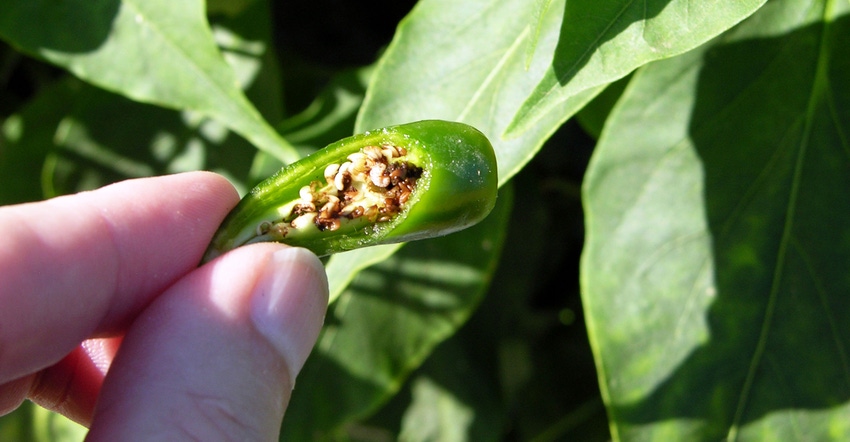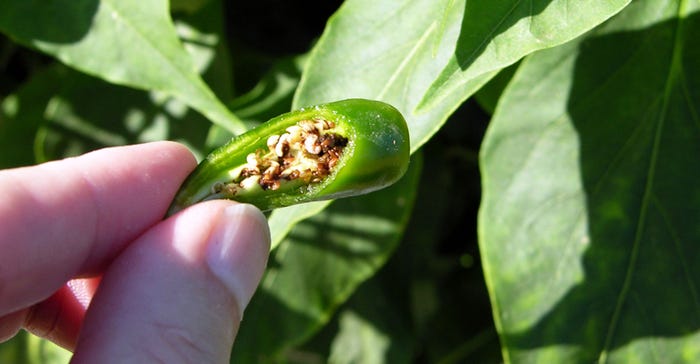June 7, 2018

Sponsored Content
Finding out you’ve got a pepper weevil infestation after harvest can be an unbelievably expensive revelation.
Adult weevils feed on buds and fruit, often depositing their eggs at the top of the fruit near the calyx. Weevil larvae feed on the inside of the pods, causing the loss of young fruit and reduced yield. Larvae also can infest mature fruit – a problem that, unfortunately, may not be discovered until your fruiting vegetable reaches market.
“There is possible overwintering of the pepper weevil,” says David Riley, University of Georgia vegetable entomologist. “Even temperatures in the low 20s do not seem to be low enough to kill these weevils.”
After experiencing a hard freeze this past winter, Riley and his colleagues went into mowed fields and collected pods still in the ground, finding weevil populations present. Another early spring survey also resulted in the documentation of weevil populations.
A multipronged approach is required to solve the problem. “We have to get a lot more vigilant than we have in the past to control this pest, both of recognizing this pest and preventing its spread,” Riley says.
Sanitation is especially important to reduce the spread of weevils from field to field. Riley advises against moving wagons or trucks that may contain infested pods from field to field, and avoiding similar movement of farm workers who may have weevils on their clothing. Also, infested fields should not have new plantings in or adjacent to these fields.
Consumers also play a part. “We looked at peppers on the shelves in grocery stores that actually had live weevils in them,” Riley says. “In the winter, a large bulk of the peppers being sold in stores originate in Mexico and other countries. It’s important that consumers do not simply discard weevils found in store-bought peppers, but instead destroy the weevils so that they are not further introduced into our production fields.”
The pepper weevil is a nondiapausing weevil. It needs food to survive, and without a food source, this pest will die within a couple of weeks.

With pyrethroids no longer providing control, and few products available for rotational use, Vydate® L can be a grower’s first line of defense against pepper weevil. Applications for pepper weevil typically begin at first flower. However, because weevils can feed on terminals and be present in pepper fields before flowering, a good scouting program is crucial to successfully controlling these cryptic pests. Pepper weevil control programs including Vydate L should begin at or before first flower and continue until or through harvest.
Vydate® L is a broad-spectrum insecticide/nematicide reliably controlling key pests in vegetable crops, including aphids, mites, thrips, leafminers, weevils, leafhoppers and several nematode species. With both foliar translaminar and soil systemic activity for top-down and roots-up control of damaging insects, yield-robbing pests and nematodes experience reduced feeding, movement, reproduction and hatching.
Vydate® L is in the carbamate family, providing increased plant health and giving growers an effective rotational partner in resistance-management programs.
®Trademark of The Dow Chemical Company (“Dow”) or E. I. du Pont de Nemours and Company (“DuPont”) or affiliated companies of Dow or DuPont. DuPont™ Vydate® L is a restricted-use pesticide. Vydate is not registered for sale or use in all states. Contact your local DuPont retailer or representative for details and availability in your state. Always read and follow all label directions and precautions for use when using any pesticide alone or in tank-mix combinations.
©2018 DuPont L14-604-001 (06/18) BR DAAG8VYDT052
You May Also Like




